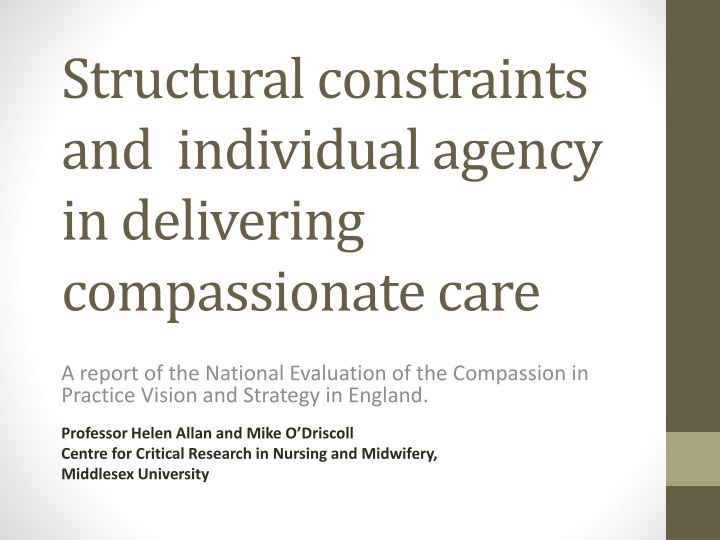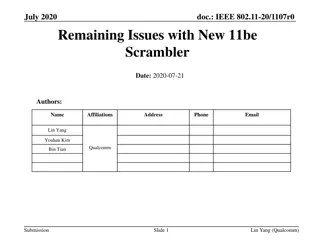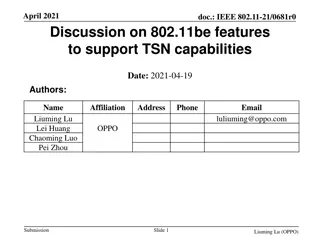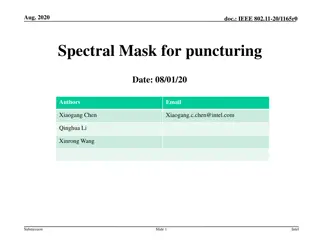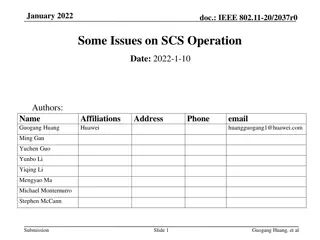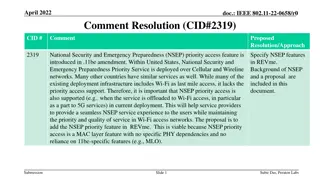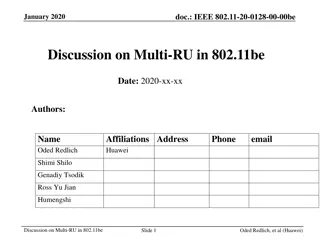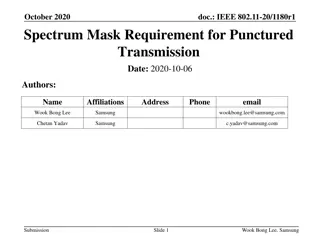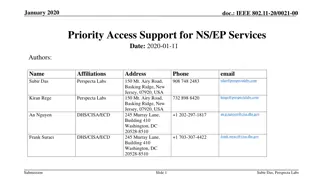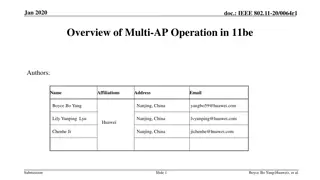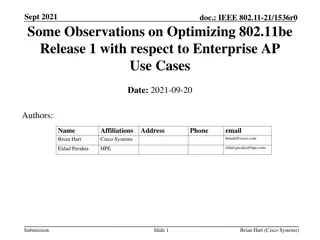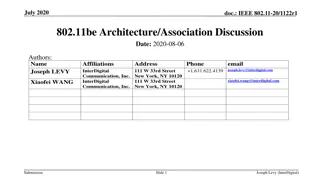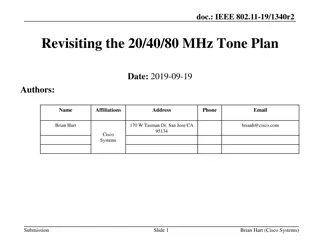Proposal for NSEP Priority Feature Addition in IEEE 802.11be Standard
This proposal aims to enhance emergency communication services by incorporating NSEP priority access features in the IEEE 802.11be standard. It addresses the importance of seamless service experience during emergencies using Wi-Fi networks, ensuring quality and prioritized access for National Security and Emergency Preparedness (NSEP) operations. The document discusses the background, need, and benefits of integrating NSEP priorities, outlining a viable approach for implementation without specific PHY dependencies.
Download Presentation

Please find below an Image/Link to download the presentation.
The content on the website is provided AS IS for your information and personal use only. It may not be sold, licensed, or shared on other websites without obtaining consent from the author.If you encounter any issues during the download, it is possible that the publisher has removed the file from their server.
You are allowed to download the files provided on this website for personal or commercial use, subject to the condition that they are used lawfully. All files are the property of their respective owners.
The content on the website is provided AS IS for your information and personal use only. It may not be sold, licensed, or shared on other websites without obtaining consent from the author.
E N D
Presentation Transcript
Structural constraints and individual agency in delivering compassionate care A report of the National Evaluation of the Compassion in Practice Vision and Strategy in England. Professor Helen Allan and Mike O Driscoll Centre for Critical Research in Nursing and Midwifery, Middlesex University
Background The Compassion in Practice Vision and Strategy in England emerged at a time when nursing and nurses in the UK were seemingly less trusted and subject to media reports of poor care (Paley 2014; Traynor 2014) Similar concerns with standards of nursing care have been raised internationally (Dewar & Christley 2013).
Compassion in Practice Vision & Strategy (NHSE 2012) In 2012 the Compassion in Practice: Nursing, Midwifery and Care Staff Vision and Strategy was launched by Jane Cummings, CNO, NHS England/Department of Health. Shared purpose of nurses, midwives and care staff to deliver high quality, compassionate care, and to achieve excellent health and wellbeing outcomes. The enduring values of the 6 Cs; Care, Compassion, Competence, Communication, Courage and Commitment.
Aims of this presentation Present findings from a national evaluation of the Impact of the Compassion in Practice Vision & Strategy (NHSE 2012) on nursing, midwifery and care staff Discuss the structural constraints against which nurses deliver care and the limits of individual agency to be compassionate
Timeline Compassion in Practice Evidencing the Impact May 2016 NHSE Phase 1 Evaluation of programme outputs by trust Phase 2 Evaluation of staff experiences (Middlesex University evaluation) Phase 3 Evidencing the Impact
Methods and analysis A mixed methods design with four sequential stages: 1. Analysis of national survey of nurses, midwives, care staff and health professionals including open-ended responses 2. Literature scoping - not reported here Case studies (n=10) qualitative telephone interviews (n=) not reported here 4. Secondary data analysis Family & Friends Test (FFT), Staff Family and Friends Test (SFFT) and NHS Staff Survey (NHSSS) Integrated analysis of all data sources. 3.
Survey 2014 CiP Survey by NHSE Has Compassion in Practice made a difference to the people we care for and our staff? The sampling frame was all NHS trusts listed on NHS Choices website (n=235) A 25.5 % random sample (n=60) stratified by speciality (acute, community and mental health) 62% (n=37) of the 60 Trusts which were sampled agreed to participate in the evaluation (this equates to 15.7% of all Trusts in England at time of survey) Data collection in June/ Jul 2015
Total survey responses n=2,267 Frequency Percent 557 947 56 110 87 6 15 54 125 268 42 2267 Nursing Ward level Nursing - Middle Management Nursing Senior Management Midwife Ward level SMCM Midwife Middle Management Midwife Senior Management Student Nurse Health Visitor Care Staff Other Please specify Not Answered Total 24.6 41.8 2.5 4.9 3.8 0.3 0.7 2.4 5.5 11.8 1.9 100
Recoded survey responses (n=1,763)
Profile of survey respondents Survey respondents by SENIORITY (n=1,763) Ward level Nursing & Midwifery 3.5% 37.8% Middle Management Nursing & Midwifery 58.7% Senior Management Nursing & Midwifery .
Involvement in CiP by seniority of respondents .
Reason for not being involved in CiP by seniority of respondents (Base: All respondents not involved in CiP and who identified their level of seniority n=1,102)
Some positive outcomes of CiP views of those who HAD heard of CiP (n=1,759) 79.6% of all respondents (in the 3 groups ward, middle management, senior management) felt that CiP was useful in supporting nurses The CiP Strategy has the ability to improve the delivery of patient care mean 4.01 The CiP Strategy has helped to improve the patient experience 3.72 The CiP Strategy has positively influenced my actions in delivering compassionate care 3.70 The CiP Strategy has supported me as a 3.58 The CiP Strategy has made a positive difference to my overall experience as a nurse/midwife 3.44
Many staff felt that they were already delivering care in ways consistent with CiP competencies base = all those NOTaware of CiP Please indicate to what extent you agree or disagree with each statement Middle Management Senior Management Nursing & Midwifery Nursing & Midwifery Ward level Nursing p on KW test & Midwifery All N The CiP Strategy has made me think about how I deliver compassionate care 3.82 3.84 4.20 3.85 1081 0.003 The CiP Strategy has helped to improve the patient experience 3.72 3.84 4.28 3.83 1070 0.000 The CiP Strategy has positively influenced my actions in delivering compassionate care 3.68 3.68 4.02 3.70 1073 0.014 The CiP Strategy has promoted a culture of compassionate care for nurses, midwives and care staff in my organisation 3.52 3.68 4.05 3.65 1060 0.000 The CiP Strategy has supported staff development 3.51 3.67 4.16 3.65 1069 0.000 The CiP Strategy has supported me as a nurse/midwife/care staff 3.48 3.57 4.17 3.58 1074 0.000
And there is some reason to think that the staff views are based in reality (MORI 2014)
Summary of open ended responses Awareness of CiP and involvement in CiP were low and varied to a statistically significant extent on the basis of role. Despite low levels of awareness and involvement many research participants felt that they were delivering compassionate care in the ways specified in CiP. Anxiety, anger and distress about the messages that CiP gives out internally to the profession and externally to patients. Many participants felt that individual agency in relation to delivering compassionate care was being stressed rather than structural constraints on delivering compassionate care which were seen as primarily to do with resourcing There was a strong message from staff, with some support from secondary data, that compassion for patients is only sustainable where there is compassion for staff. Many participants expressed directly or indirectly that they did not feel they were being treated with compassion.
Value of the 6 Cs Overall staff felt the 6Cs had helped to focus and highlight their work. It s something I feel is very important. The 6Cs encapsulated everything, but it s something I ve been concerned about for a while, that nurses are becoming very technically proficient in many ways, but that the fundamental essentials of being a nurse and coming across as a nurse who can be approached, relied upon, friendly, knowledgeable - if they don t know, they ll put you in touch with someone who can - is perhaps beginning to be missed a little bit, not just within this Trust, I feel nationally (Site 5)
Structure and culture Structural issues (high workload, lack of resources, paperwork) shape the delivery of compassionate care. Although most staff are aware of the Compassion in Practice, not enough is really known at floor level. The majority of the nursing staff always work to their extreme best in delivering care to patients. Lack of resources, equipment and the constant movement of having to outlie patients instead of caring for them in a safe environment often results in the interruption of the continuation of care and delays safe discharging. (14 Nursing middle management) Cultural change (prevent bullying, support ward level staff) is required to support compassionate care delivery. We are still working in a culture driven by anxiety and defensiveness which works against the ability to give compassionate care. Until the blame culture is widely discussed nurses don t feel supported or safe and are over anxious. (413 Nursing ward level)
Demoralising effect of Francis Our findings should be viewed in the context of discourses on compassion and recent literature on the Francis Report. When I read the Francis report and it was one of those that I had to go back to and read in bite-sized chunks because a lot of it didn t make pleasant reading as you know (Site 2).
Conclusions 1 Communication about Compassion in Practice could be cascaded more effectively across the NHS to share good practice Compassion in Practice must be developed and extended to all staff so that it becomes embedded across all roles and all types of Trust
Conclusions 2 Barriers to compassionate care need to be addressed at individual agency AND structural levels To focus purely on individual agency implies that all that is required for compassionate care is for staff to change their attitudes or behaviour when clearly this would not be sufficient condition for more compassionate care Staff were clear that they were already delivering compassionate care and that although staff could improve their understanding & delivery of compassionate care, the most significant barriers to this were resources and management styles (i.e. structural)
Conclusions 3 Even if one accepted that change in individual agency was the correct level at which to address Compassion in Practice, communications between management and ward level staff were so poor so that awareness and involvement in the CiP initiative were low. So CiP had limited potential to inform or impact on individual behaviour or attitudes Recognition and action is needed at the Trust leadership level and from NHS England to address the challenges staff face to deliver care, including a bullying work culture and structural constraints related to staffing levels and funding
References Allan, H.T, O Driscoll, M., Corbett, K., Liu, L. (2016) Evaluation of the National CiP Vision & Strategy Full Report, Middlesex University Dewar B and Christley Y (2013) A critical analysis of compassion in practice, Nursing Standard, 28 (10) 44-49 MORI (2014) Public Perceptions of the NHS and Social Care - Winter 2014 https://www.ipsos- mori.com/Assets/Docs/Publications/SRI_Health_NHS_Tracker_Winter_Tables_20 14.pdf Accessed 25.2.17 NHS England/Professor Laura Serrant (2016) Compassion in Practice - Evidencing the impact https://www.england.nhs.uk/wp-content/uploads/2016/05/cip-yr- 3.pdf Accessed 25.2.17 Paley J (2014) Cognition and the compassion deficit: the social psychology of helping behaviour in nursing. Nursing Philosophy 15(4) 274-87. Traynor M (2014) Caring after Francis: moral failure in nursing reconsidered. Journal of Research in Nursing, 19, 7-8: 546-556.
Presentation and full evaluation report available at site below from 7thApril https://tinyurl.com/lwve7jj Or scan QR code with your phone: or contact: h.allan@mdx.ac.uk m.o driscoll@mdx.ac.uk
